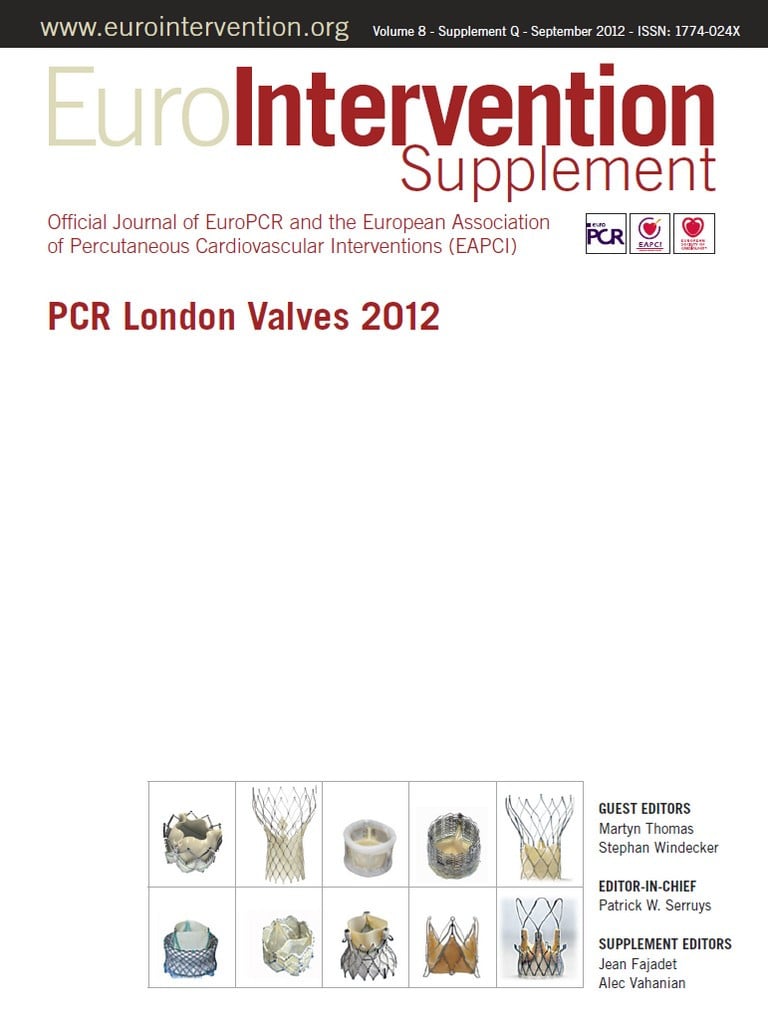![]()
Single and multicentre TAVI registries
The Ibero-American Transcatheter Aortic Valve Implantation Registry: acute and long-term results
Aims: To evaluate immediate and long-term results of transcatheter aortic valve implantation (TAVI) with the CoreValve system in consecutive “real world” patients with severe aortic stenosis.
Methods and results: This is a retrospective analysis of 1,170 consecutive patients who underwent TAVI in 42 centres from Spain, Portugal and Latin America from December 2007 to March 2012. Statistical analysis was performed with PAWS 18. p<0.05 was used for statistical significance. Percentages, χ2 and the Fisher test are presented for categorical variables, and mean±SD or median (range) and Student’s T-test for continuous variables. Kaplan-Meier curves are presented for estimates of long-term outcomes. Age was 81.4±6.3 years, mean logistic EuroSCORE was 17.8±13.1, and 55% of the patients were male. Baseline comorbidities: 33% of the patients were diagnosed with diabetes mellitus, 30% had prior coronary revascularisation, 11% myocardial infarction, 11% stroke or transient ischaemic attack, 13.5% extra-cardiac arteriopathy, 22% chronic renal failure, 35% chronic obstructive pulmonary disease (COPD), 18% had moderate or severe mitral regurgitation, 19% severe pulmonary hypertension and 14.5% had an LVEF <40%; 79% of the patients were in NYHA functional Class III or IV. TAVI was performed through a femoral access in 95% of the patients, and planned vascular closure was successful in 88%. Procedural success was reported in 96% and post-procedural aortic regurgitation was ≤2 in 95% of the patients. In-hospital mortality was 7.3%, and the in-hospital combined safety endpoint according to the Valve Academy Research Consortium (VARC) definition was 85.8%. A second valve-in-valve was implanted in 4% of the patients and a permanent pacemaker in 25%. 131 patients were lost to follow-up. Of the remaining patients, 88% were in NYHA Class I or II at one month, 91% at 12 months and 94% at 24 months. Kaplan-Meier estimates of freedom from total and cardiac mortality at two years were 53% and 73%, respectively, and mortality was related to the baseline logistic EuroSCORE (mortality at two years of 19% for those with a logistic EuroSCORE <10%, 46% for logistic EuroSCORE between 10% and 20% and 53% for those with logistic EuroSCORE >20%, p<0.001; cardiac mortality of 10%, 17% and 29% for the same subgroups, p<0.001). Mortality after hospital discharge was related to prior extracardiac arteriopathy (p=0.048), insulin treatment (p<0.001), severe COPD (p=0.011), coronary artery disease (p=0.012), known severe pulmonary hypertension, liver cirrhosis (p=0.007) and the occurrence of post-procedural complications (p=0.003), stroke (p<0.029) or renal failure stage 3 (p=0.002). Freedom from hospital admission for cardiac causes was 63%, with no differences between logistic EuroSCORE groups.
Conclusions: TAVI with the Medtronic CoreValve system in the “real world” is feasible, safe and associated with a marked improvement in functional status and a low mortality rate at follow-up. Death after hospital discharge is related to baseline comorbidities and to in-hospital complications.

